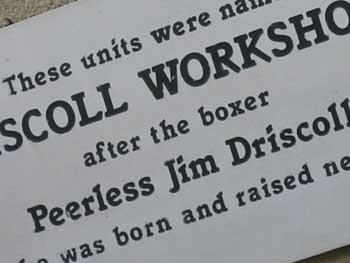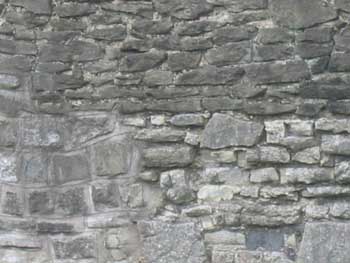Can a whole district - houses, people, even the name - simply disappear?
They can. Ask your average Cardiffian if they know where Newtown is
and they'll tell you it's in mid-Wales. Of the vanished local little
Ireland they know nothing at all. I'd first heard of the slum-cleared
Newtown by following a link from Barry Tobin's now vanished Welsh-Irish
website. Barry, a former librarian, multi-linguist and expert on the
Irish Famine, had more local Irish links running off his html creation
than the Pope. Scrape the Cardiff surface and you'll find shamrocks
underneath. Barry may be a comparatively late arrival here but as
a networker he was worth his weight in native sod.
Newtown was built by Bute in 1846 to house Irish workers fleeing
the potato famine by sailing from Cork as human ballast on the coal
ships that plied industrial trade across St George's Channel. Cardiff
was a boom town with a vast need for labour. Docks were to be dug,
railways laid, buildings to be slung up, pig iron to be loaded. The
district consisted of six streets - Pendoylan Street, Roland Street,
North William Street, Rosemary Street, Pendoylan Place and Ellen Street
- two hundred houses - jammed, insanitarily, back-to-back, in the
sliver of ground between the main rail line and Tyndall Street. A
warren of bedrooms used in relays above cramped, over-occupied parlours
and damp, unventilated kitchens were home to more than a thousand
desperate immigrants. There were shops, pubs (five in one street alone
in the early years) and two churches - the Roman Catholic St Pauls's
which was permanently full and dominated local life almost as much
as the drink did and the Welsh All Saints which scratched a congregation
from somewhere, just. There was smoke and unsurfaced streets, steam
and roofs which leaked, the roar of the steel works and the clank
and clatter of a thousand passing trains. Newtown was never silent.
you could always hear your neighbour breathing. There were tiny back
yards made from uneven flag and rough grass. There were no trees.
Not one.
Newtown wasn't the only Irish area of Cardiff - the Hayes, and the
cramped courts and back streets around Bridge and Mary Ann Streets
were almost uniformly green - but Newtown was an island. Bounded by
the rail line to the north, the goods yard to the east, feeder to
the west, and the dock itself to the south it developed a particularly
strong sense of community. You did not travel through it, you went
there to arrive.
Mary Sullivan, who runs the present day Newtown Association, a sort
of virtual Cardiff Irish community of the web , was born in Newtown
and is the centre of many commendable attempts to keep the name alive.
Her grandmother shoveled potatoes for Edward England from boats wharfed
at the top of West Bute, three hundred yards from Ellen Street. England's
warehouse is still there, stranded, the filled-in West Bute now a
manicured park, the factories around it turned to offices or glitz
glass apartment. We meet in the forecourt. I'm carrying a newspaper
so she can recognise me. The Western Mail, news of the Irish troubles
still on page one. She leaves her car where the wharf edge once was,
next to a berberis bush, planted for the enjoyment of new residents
at the nearby Lloyd George Avenue apartments. Money talks. Newtown
never had any.

sign at the workshop's
entrance
We cross Tyndall Street, full of passing traffic now, past the Willis
Corroon Group building and the tiny site for the proposed Newtown
Memorial Garden. Mary is proud of this, Tarmac have donated the land,
Sir Geoffrey Inkin and the old CBDC have put up some development cash,
artist David Mackie has planned the layout, all that's needed now
is the lottery money to build. Do it soon, I urge, before the developers
use the space for something else. The area once filled by Newtown
is now Atlantic House, the Peacock Group headquarters high rise, with
Doug Corker's 1991 art work, looking a lot like an oversize car badge,
to its front; and the Tyndall Street Industrial Estate - stores, small
workshops, the premises of greetings card agents, Rock Bottom Wholesale,
Nature's Table Wholefoods, Fireworks & Diecast Collectables. Inner
city commerce. Round the back will be dumpsters full of cardboard
waste. Inside, denim-clad truck loaders drinking tea. The name of
Newtown is utterly invisible. We walk in strong sun, Mary pointing
out the sites of the old pubs - the Crichton Arms, Tobins, the Cambridge,
the Duke of Edinburgh, where the corner shop was, the single telephone
box. Ellen Street is still there, leading to the Driscoll Workshops,
named after Newtown's most famous son. In the early years of the twentieth
century Peerless Jim Driscoll was Featherweight Champion of the World.
All eyes were on Newtown. When he died in 1925 100,000 people lined
the streets to watch his funeral cortege go by. The statue the city
has erected to his memory is elsewhere, at the top of Bute Street.
Ellen Street, where he was born, lived and died, has the Workshops
- King Oak Network Installers, Brolec Electrical Contractors, Motor
Tint Door and Window Maintenance.
Going back down Ellen Street a week later to check out the occupants
of some of the units I spot a bloke in jeans fixing a Rover 414sli
on the pavement outside an electrical wholesalers. He's got half the
engine out and a whole passenger door lying on the pavement. It's
amazing what you can manage to mend in your lunch break. I ask him
if he knows about Newtown. Newtown, mate, nah, not round here. No,
I insist, Newtown the old district. District? Never heard of it. He's
changing spanners and pulling furiously at some engine part which
won't budge. What about Jim Driscoll? Yeah, heard of him. He was a
boxer, right? Back in the twenties. We knew how to do things then.
Sport, the people's history. Much better than the young researcher
for a new Bay area TV company making a sports quiz who came down here
recently looking for the legend with a view to getting him onto the
panel.

The last wall in
Newtown
By the time Newtown was marked for demolition in 1966 it had 169
falling-down houses, two pubs and a garage. Half its population called
themselves Welsh rather than Irish, but their names - O'Sullivan,
O'Leary, Burns, O'Shanahan, Dwyer - gave away their origins. A proposal
that the district should be rebuilt where it stood was unaccountably
defeated. Families were dispersed to Ely, Pentrebane, Trowbridge,
and Llanrumney. The community broken. In 1970 St Pauls, the church,
the school and the presbytery, went too in order to make space for
the Central Link Road flyover, the route from the changing city to
the redeveloping bay.
All that's left today are the fourteen standard-pattern council houses
built late on the bobtail, waste ground once fronting Tyndall Street.
This was a red-light district for a time after the prostitutes were
moved up off the newly cleansed Bute Street. They are west of here
today near the Central Station. I ask someone mowing their front lawn
if she knew about little Ireland. Yes. Mrs Kitchen next door lived
here when the houses still stood. So what's the area called today?
Where do you live? Atlantic Wharf, she replies without a flicker.
The mower roars.
The Newtown Association is at www.newtown-cardiff.org.uk
. Among many other delights it contains the complete text of
Tommy Walsh's "The Parish of St Pauls", a sociological history
of the district in verse. Barry Tobin's excellent all-irish site is
now at www.ballinagree.freeservers.com

Peter Finch
back to the top